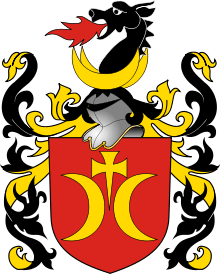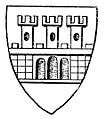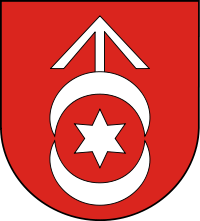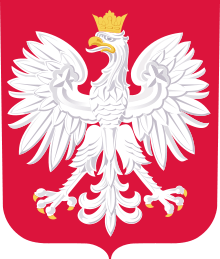Polish heraldry
.svg.png)
Polish heraldry is a branch of heraldry focused on studying the development of coats of arms in the lands of historical Poland (and the Polish-Lithuanian Commonwealth), as well as specifically-Polish traits of heraldry. The term is also used to refer to the Polish heraldic system, as opposed to systems used elsewhere, notably in Western Europe. As such, it is an integral part of the history of the szlachta, the nobility of Poland.
Due to the distinct manner in which feudal society evolved in Poland, the heraldic traditions of Poland differ significantly from those in German lands, France or the British Isles.
History
Unlike the case of Western Europe, in Poland, the szlachta did not emerge exclusively from the feudal class of knights under Chivalry, but stemmed in great part from an earlier Slavic local rulers, free warrior class and mercenaries. Rulers often hired these free warriors and mercenaries to form guard units (Polish Drużyna)[1] And eventually, in the 11th century during the time of Casimir I the Restorer and the development of feudalism, armies that was paid by the Prince where replaced by the knights that was paid in land.[2] Much written evidence from the Middle Ages demonstrates how some elements of the Polish nobility did emerge from former Slavic rulers that where included in the ranks of the knightly class under the terms of chivalric law (ius militare) and iure polonico'.[3][4]
As Polish clans (Polish: Rody) show different origins, only part of the szlachta can be traced all the way back to the traditional old clan system based on kinship. The clans that could show such kinship belonged to a House (Polish: Dom),[5] like House of Odrowąż. Later, when different lines of the House created different surnames after their properties, the House turned into a Clan Odrowąż, if relation between clan members was still based on genealogical kinship, having common ancestors. Other szlachta were not related and their unions were mostly voluntary and based on followership and brotherhood rather than kinship, still being full members of the Clan creating Clan politics like in Clan Ostoja or Clan Abdank but forming Heraldic clan. In the end, due to adpotions and other circumstances, all Clans in Poland turned into Heraldic Clans.[6][7]

In the year 1244, Bolesław, Duke of Masovia, identified members of the knights' clan as members of a genealogia:
"I received my good servitors [Raciborz and Albert] from the land of [Great] Poland, and from the clan [genealogia] called Jelito, with my well-disposed knowledge [i.e., consent and encouragement] and the cry [vocitatio], [that is], the godło, [by the name of] Nagody, and I established them in the said land of mine, Masovia, [on the military tenure described elsewhere in the charter]."
The documentation regarding Raciborz and Albert's tenure is the earliest surviving of the use of the clan name and cry defining the honorable status of Polish knights. The names of knightly genealogiae only came to be associated with heraldic devices later in the Middle Ages and in the early modern period. The Polish clan name and cry ritualized the ius militare, i.e., the power to command an army; and they had been used some time before 1244 to define knightly status.[8]
According to Polish historian Tadeusz Manteuffel, a Polish clan (ród) consisted of people related by blood and descending from a common ancestor, giving the ród/clan a highly developed sense of solidarity (see gens). The starosta (or starszyna) had judicial and military power over the ród/clan, although this power was often exercised with an assembly of elders. Strongholds called gród were built where a unifying religious cult was powerful, where trials were conducted, and where clans gathered in the face of danger. The opole was the territory occupied by a single tribe.[9] Such clans often used signs (proto-Coat of Arms)[10] that later, during 13th century become Coat of Arms of the House or the Clan. The origin of those proto-CoA is controversial. Some, like Sulimirski, clame Sarmatian origin[11] and some like Piekosiński claim that those signs are Runes of dynastic tribal rulers.[12][13]
Heraldic symbols began to be used in Poland in the 13th century.[14] The generic Polish term for a coat of arms, herb, was used for the first time in year 1415 at the Royal Office with text et quatuor herbis,[15][16] originating as a translation of the Czech erb, which in turn came from the German Erbe - heritage.[17][18]
During the Union of Horodło (1413), 47 Prince and Boyar families of the Grand Duchy of Lithuania were adopted into 47 Polish noble clans and began to use Polish coats of arms.[19]
Medieval Polish Coat of Arms
Since there was no Heraldic authority in Poland or in the Polish–Lithuanian Commonwealth, many old Polish coats of arms were in time changed by different publications, losing their original appearances. Heraldic Commission (pl:Komisja Heraldyczna) was registrated on 20 January 2010.[20] Although many medieval Polish coats of arms were presented in several Western European Roll of arms,[21] there were no publications that presented original coats of arms in Poland until the 20th century, until pl:Adam Heymowski began to work on recovering old Polish coats of arms. His work was continued by Professor pl:Józef Szymański (historyk) that finally published Armorial of original Polish CoA.[22]
Ancient Pałuki[23] family and their CoA was visiually close to Topór CoA and it was in time incoorporated to Clan Topór, using similar CoA.[24] Next, evolution of Ostoja CoA where the Dragon was replaced by feathers and the cross by the sword followed by other differences between ancient and modern versions.[25] Also, in many Polish coat of arms there are so called variations of the CoA which is very special for Polish heraldry. In many cases, variations are simple errors, sometimes family wished to make difference inside the Clan and in other cases CoA have been called variation instead of CoA of certain family CoA just because they look similar which all together create unique Heraldic clan organisation in Poland. This is presented in second row of the gallery showing many different variations of Ostoja coat of arms.[26][27][28]
 Pałuki CoA according to Szymański
Pałuki CoA according to Szymański Topór CoA, modern version
Topór CoA, modern version ancient Ostoja CoA
ancient Ostoja CoA Ostoja CoA, modern version
Ostoja CoA, modern version Grzymała of comes Mroczek in 1262
Grzymała of comes Mroczek in 1262 Grzymała CoA, modern version
Grzymała CoA, modern version ancient Wadwicz CoA
ancient Wadwicz CoA Wadwicz CoA, modern version
Wadwicz CoA, modern version ancient Szreniawa CoA
ancient Szreniawa CoA Szreniawa, modern version
Szreniawa, modern version
None of variations above have anything incommon with Ostoja, just that they look similar. From the left: CoA of Fincke von Finkenthal family that received nobility in 1805, Ostarzewski family that received nobility in 1785, Krall family that received nobility in 1768. Next is CoA of Szyszko family followed by CoA of Turkuł and then Wysocki family belonging to the Clan of Kolumna with specific variation called "Kolumna with wings", still noted as variation of Ostoja. After Wysocki, CoA of Zawadzki family, Mokrzewski, Wasilewski and finally CoA of Orda family.[29][30]
Starting with proto-CoA and families like Odrowąż being House of Odrowąż, Polish family names were appended in many cases with –cki or –ski in reference to the name of their properties; for example, if a person named Chelmski acquired the town of Poniec, he would change his surname to Poniecki.[31] Furthermore, Jerzykowski (de Jerzykowo) that owned property of Baranowo changed his surname to Baranowski (de Baranowo) and Baranowski that owned property of Chrzastowo change the surname to Chrzastowski (de Chrzastowo).[32] A family become a Clan or "Heraldic family" using same CoA. Later, when Clans adopted several families, they formed Heraldic clan, families using same CoA, in many cases defending Clan politics but not necessary blood related to each other.[26]
Peculiarities


Although the Polish heraldic system evolved under the influence of French and German heraldry, there are many notable differences.
The most striking peculiarity of the system is that a coat of arms does not belong to a single family. A number of unrelated families (sometimes hundreds of them), usually with a number of different family names, may use the same, undifferenced coat of arms, and each coat of arms has its own name. The total number of coats of arms in this system was relatively low – ca. 160 (Piekosinski) in the late Middle Ages. The same can be also seen in Western Europe, when families of different surnames but sharing clan origin would use similar coats-of-arms, the fleur-de-lis of the many Capetian families being perhaps the best known example.
One side-effect of this unique arrangement was that it became customary to refer to noblemen by both their family name and their coat of arms name (or clan name). For example: Jan Zamoyski herbu Jelita means "Jan Zamoyski of the Jelita coat of arms" (though it is often translated as "of the clan Jelita" or herbu is Latinized de armis). From the 15th to 17th centuries, the formula seems to have been to copy the ancient Roman naming convention: praenomen (or given name), nomen gentile (or Gens/Clan name) and cognomen (surname), following the Renaissence fashion. So we have: Jan Jelita Zamoyski, forming a double-barrelled name (nazwisko złożone, literally "compound name"). Later, the double-barrelled name began to be joined with a hyphen: Jan Jelita-Zamoyski. (See Polish names).
The Polish émigrés of the 19th century sometimes used adaptations of their names according to the Western European (mainly French) style, becoming e.g. Balthasar Klossowski de Rola (Balthus), Jean de Bloch (Jan Gotlib Bloch), or Tamara de Lempicka. Some would also keep the Latin forms of their surnames, as Latin was the official language of the Kingdom of Poland, hence the popularity of Late-Medieval or Early-Modern forms such as "de Zamosc Zamoyski".
A single coat of arms could appear in slightly different versions, typically in different colours, depending on the custom of the family using it. Such variations (odmiany) are still considered as representing the same coat of arms.
One of the most visually striking characteristics of Polish heraldry is the abundance of gules (red) fields. Among the oldest coats of arms in Poland, nearly half use a red background, with blue (azure) coming in a distant second. Nowhere else in Europe is there seen such a strong bias towards a particular colour scheme. It follows however the well-known heraldic custom of all Europe, of the vassals following the colour-scheme of their overlord, which found practical use on the battlefield.
Other typical features used in Polish heraldry include horseshoes, arrows, Maltese crosses, scythes, stars and crescents. There are also many purely geometrical shapes for which a separate set of heraldic terms was invented. It has been suggested that originally all Polish coats of arms were based on such abstract geometrical shapes, but most were gradually "rationalized" into horseshoes, arrows and so on. If this hypothesis is correct, it suggests in turn that Polish heraldry, also unlike western European heraldry, may be at least partly derived from the Tamgas, marks used by Eurasian nomads such as the Sarmatians,[11] Avars and Mongols, to mark property. Evidence of the origins of the system was considered scanty, and the hypothesis has been criticized as being part of "Sarmatism" (the Polish tradition of romanticizing their supposed Sarmatian ancestry). However, recent DNA projects that concern Polish Nobility proved that at least part of Polish Nobility is of Sarmatian origin.[33][34][35]
A Polish coat of arms consists of: shield, crest, helm and crown. Mantling became fashionable during the 18th and 19th centuries. Supporters, mottos and compartments normally do not appear, although certain individuals used them, especially in the final stages of the system's development, partly in response to French and German influence. Preserved medieval evidence shows Polish coats-of-arms with mantling and supporters.
Shield
Polish coats of arms are divided in the same way as their western counterparts. However, since coats of arms were originally granted to clans rather than to separate families, there was no need to join coats of arms into one when a new branch of a family was formed. Thus Polish escutcheons are rarely parted. There are however a lot of preserved quartered coats-of-arms. These would most often show the arms of the four grandparents of the bearer. Or also the paternal-paternal great-grandmother in the 5th field if the male-line coat-of-arms goes in the heart field.
| Example |  |
 |
 |
 |
 |
|---|---|---|---|---|---|
| English name | Parted per fess | Parted per pale | Parted per bend sinister | Parted quarterly | Parted quarterly with an inescutcheon |
| Polish name | tarcza dwudzielna w pas | tarcza dwudzielna w słup | tarcza dwudzielna w lewy skos | tarcza czterodzielna w krzyż | tarcza czterodzielna w krzyż z polem sercowym |
The tradition of differentiating between the coat of arms proper and a lozenge granted to women did not develop in Poland. Usually men inherited a coat of arms from their fathers (or a member of a clan who had adopted them), while women either inherited a coat from their mothers or adopted the arms of their husbands. The brisure was rarely used. All children would inherit the coat-of-arms of their father.
Heart-shaped shields were mostly used in representations of the coats of arms of royalty. Following the union between Poland and Lithuania, and the creation of the elective monarchy, it became customary to place the coats of Poland and Lithuania diagonally, with the coat of arms of the specific monarch placed centrally on top. Research continues to find out what a "heart-shaped" shield is. Most likely, the coat of Poland was placed on the left-right diagonal (I & IV)and Lithuania on the right-left diagonal (II & III) as evidenced in the shield at the top of this page. The specific monarch crest then being placed in the "heart" position.
Tinctures
| Tincture | English heraldic name | Polish heraldic name |
|---|---|---|
| Metals | ||
| Gold/Yellow | Or | Złoto |
| Silver/White | Argent | Srebro |
| Colours | ||
| Blue | Azure | Błękit |
| Red | Gules | Czerwień |
| Purple | Purpure | Purpura |
| Black | Sable | Czerń |
| Green | Vert | Zieleń |
In addition to these seven basic tinctures, which were standard in English heraldry and elsewhere in western Europe, many more tinctures were used in Poland and (after the union with Poland) Lithuania, including grey, steel, brunatre, weasel and carnation.
See also
- Coat of arms
- Heraldry
- History of Poland
- List of coats of arms of Polish nobility
- List of Polish nobility coats of arms images
- Szlachta
- Belarusian heraldry
- Polish name
- Polish clans
- Coats of arms of Polish voivodeships
References
- ↑ Tadeusz Nowak, Jan Wimmer, "Historia oręża polskiego 963-1795", Wiedza Powszechna, Warszawa 1981, ISBN 8321401333, str.33. Drużyna was formed by younger units (majority) and older units of magnates and descedents of former local rulers that also where part of the council of war of the Ruler
- ↑ J. Wyrozumski Historia Polski do roku 1505, Państwowe Wydawnictwo Naukowe, Warszawa 1986, rozdz. IV,13, str. 97
- ↑ Franciszek Piekosiński Polish Knights during the Middle Ages, 1901
- ↑ J. Bardach, B. Leśnodorski, M. Pietrzak, Historia państwa i prawa polskiego, Warszawa 1976, ISBN 83-01-00104-6
- ↑ Herby rycerstwa polskiego przez Bartosza Paprockiego zebrane i wydane r. p. 1584; wydanie Kazimierza Józefa Turowskiego, 1858, Wielkopolska Biblioteka Cyfrowa
- ↑ [Wladyslaw Semkowicz, Clan Abdank i Medieval time http://www.wbc.poznan.pl/dlibra/plain-content?id=119155]
- ↑ Lukasz Lapinski, PhD in Polish history using DNA evidence to claim clan origin and structure
- ↑ (Górecki 1992, pp. 183–185)
- ↑ (Manteuffel 1982, p. 44)
- ↑ Heraldyka - Początki herbów rycerskich w Polsce
- 1 2 T. Sulimirski, The Sarmatians, Thames & Hudson Ltd (December 1970), ISBN 978-0500020715
- ↑ O dynastycznem szlachty polskiej pochodzeniu, 1888
- ↑ P. Dudziński, Alfabet heraldyczny, Warszawa 1997, s. 208–220
- ↑ J. Bieniak, Heraldyka polska przed Długoszem, [w:] Sztuka i ideologia XV w., pod red. P. Skubiszewskiego, Warszawa 1978, s. 192
- ↑ Białek W., Swarzędz 1638-1988, Swarzędz 1988
- ↑ historia.org - first section and citation
- ↑ Herb, explained in official page of City of Warsaw
- ↑ PWN - Słownik języka polskiego pod red. W. Doroszewskiego (last sentence)
- ↑ Lidia Korczak (red.): Unia horodelska 1413. Wydawnictwo Uniwersytetu Jagiellońskiego, Kraków 2014, ISBN 978-83-233-3841-3
- ↑ Dziennik Ustaw z 2000 r. Nr 6 poz. 83
- ↑ Almanach de Gotha, Gelre Armorial, Codex Berghammar, fr:Grand Armorial équestre de la Toison d'or, Stemmata polonica, fr:Armorial Bellenville, de:Armorial Lyncenich
- ↑ Józef Szymański, Herbarz rycerstwa polskiego z XVI wieku. Warszawa: Wydawnictwo DiG, 2001. ISBN 978-83-7181-713-7
- ↑ Semkowicz W. Jeszcze o rodzie Pałuków Wiad. Numizm. Archeolog. 21(1939/1948), s. 96-107
- ↑ Paweł Dudziński: Alfabet heraldyczny. Warszawa: Diogenes, 1997, s. 209. ISBN 83-01-09797-3
- ↑ Alfred Znamierowski: Herbarz rodowy. Warszawa: Świat Książki, 2004, s. 25. ISBN 83-7391-166-9.
- 1 2 Tomasz Gajl, Herby Szlacheckie Rzeczypospolitej Obojga Narodów, Wydawnictwo L&L 2005, ISBN 9788388595981, Introduction chapter
- ↑ Stanisław Dumin, Herbarz rodzin tatarskich Wielkiego Księstwa Litewskiego, Wyd. I, Gdańsk, Związek Tatarów Polskich, 1999, s. 16-18 ISSN 1234-9267
- ↑ Bartosz Jankowski, Smok w herbach szlachty polskiej, pismo historyczno-społeczne 14/2 (2007), p.97-116
- ↑ More research of Orda family history is necessary to esttablish possible connection of the family to Ostoja. In work of Niesiecki, there is note about Orda family that used Ostoja CoA in the 16th century, although this source is not reliable.
- ↑ Tadeusz Gajl, Herbarz polski od średniowiecza do XX wieku, L&L, Gdańsk 2007 ISBN 978-83-60597-10-1
- ↑ http://www.poniec.pl – “Jak Chelmscy stali sie Ponieckimi”
- ↑ IH PANhttp://www.slownik.ihpan.edu.pl/search.php?id=3775
- ↑ Lukasz Lapinski, PhD in Polish History, administrate several DNA projects, including entire R1a together with international scientific team https://www.familytreedna.com/public/POL-LITHNOBILITY/default.aspx
- ↑ Researcher Ornella Semino was the first one to show Kurhan DNA to be R1a1 and that their ancestors was of Scythian and Sarmatian origin. The genetic legacy of Paleolithic Homo sapiens sapiens in extant Europeans: a Y chromosome perspective. "Science". 290 (5494), s. 1155-1159, 2000
- ↑ Genetic discovery 2010/2015
Sources
- Górecki, Piotr (1992). Economy, Society, and Lordship in Medieval Poland: 1100-1250. New York, NEW YORK: Holmes and Meier Publishers, Inc. ISBN 0-8419-1318-8. OCLC 25787903
- Manteuffel, Tadeusz (1982). The Formation of the Polish State: The Period of Ducal Rule, 963-1194. Detroit, MICHIGAN: Wayne State University Press. ISBN 0-8143-1682-4. OCLC 7730959
- "Ślady recepcji legend arturiańskich w heraldyce Piastów czerskich i kronikach polskich". Kultura i Historia: Uniwersytet Marii Curie Skłodowskiej w Lublinie (in Polish). 2010 (17). 2010. ISSN 1642-9826.
- Wojciech Górczyk (2009). "Półksiężyc, orzeł, lew i smok. Uwagi o godłach napieczętnych Piastów". Histmag.org (in Polish). Histmag.
Further reading
Armorials and Listings of Coats of Arms
Traditionally coats of arms were published in various listings of szlachta and in armorials, known in Polish as herbarz. Such publications, akin to Almanach de Gotha or Gelre Armorial and descended from the tradition of rolls of arms, appeared in Poland regularly from the 15th century onwards. The first such armorial was Insignia seu clenodia incliti Regni Poloniae by Jan Długosz. In recent years growing interest in family histories has led to publication of numerous newly compiled listings of coats of arms and families. Some of the most notable among such publications are:
- Bartosz Paprocki (1578). Gniazdo cnoty [Nest of Virtue] (in Polish). Kraków.
- Herby rycerstwa polskiego [Arms of Polish Knighthood] (in Polish). Kraków. 1584.
- Antoni Swach (1705). Herby Polskie [Polish Coats of Arms] (in Polish). Poznań.
- Szymon Okolski (1643). Orbis Polonus [Polish World] (in Latin). 1–3. Kraków.
- Jan Karol Dachnowski; Z. Pentek (1995) [First published ca. 1620]. Herby szlacheckie w ziemiach pruskich [Coats of Arms in Prussian Lands] (in Polish). Kórnik.
- Jan Karol Dachnowski (c. 1634). Poczet możnego rycerstwa polskiego [List of Grand Knights of Poland] (in Polish).
- Wacław Potocki (1696). Poczet herbów szlachty Korony Polskiey i Wielkiego Xsięstwa Litewskiego [List of Coats of Arms of Gentry from the Crown of Poland and the Grand Duchy of Lithuania] (in Polish). Kraków.
- Kasper Niesiecki (1728). Herby i familie rycerskie tak w Koronie jako y w W.X.L. [Coats of Arms of Knights both in the Crown and the Grand Duchy] (in Polish). Lwów.
- Kasper Niesiecki (1728–1743). Korona polska [Crown of Poland] (in Polish). Lwów.
- Benedykt Chmielowski (1763). Zbiór krótki herbów polskich, oraz wsławionych cnotą i naukami Polaków [Short Collection of Polish Coats of Arms, as well as Poles Famed for their Virtues and Sciences] (in Polish). Warsaw.
- Leonhard Dorst (1842–1849). Schlesisches Wappenbuch oder die Wappen des Adels im souverainen Herzogthum Schlesien, der Grafschaft Glatz und der Oberlausitz [Silesian Armorial, or Coats of Arms of the Duchy of Silesia, Duchy of Glatz and Lower Lausatia] (in German). Görlitz.
- Nikolay Ivanovich Pavlischev (1853). Herbarz rodzin szlacheckich Królestwa Polskiego najwyżej zatwierdzony [Armorial of Noble Families of the Kingdom of Poland, Approved by Highest Authorities] (in Polish).
- Poczet szlachty galicyjskiej i bukowińskiej (in Polish). Lwów-Kraków: Krajowa Agencja Wydawnicza. 1988 [First published - 1857].
- Seweryn Uruski (1904–1938). Rodzina. Herbarz szlachty polskiej [The Family. Armorial of Polish Gentry] (in Polish). Warsaw. (published in 15 volumes, unfinished)
- Emilian von Zernicki-Szeliga (1900). Der Polnische Adel und die demselben hinzugetretenen andersländischen Adelsfamilien (in German). Hamburg: Verlag von Henri Strand.
- Franciszek Piekosiński (1899). Herbarz szlachty prowincyi witebskiej [Armorial of Gentry of the Province of Vitebsk] (in Polish). Kraków: Herold polski.
- Tadeusz Gajl (2003). Herby szlacheckie Rzeczypospolitej Obojga Narodów [Coats of Arms of the Republic of Both Nations] (in Polish). Białystok. ISBN 83-88595-12-1.
External links
| Wikimedia Commons has media related to Heraldry of Poland. |
| Wikimedia Commons has media related to Coats of arms of families of Poland. |
- Polish coats of arms - a full list of Polish coats of arms
- Polish Nobility and Its Heraldry
- Armorial
- Coats of Arms within the context of the hereditary aristocracy of the historic Polish-Lithuanian Commonwealth












